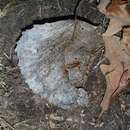mk
имиња во трошки


The striped scorpions body is covered with a waxy cuticle that helps prevent dessication. The scorpion cuticle flouresces under ultraviolet light, which helps when collecting or observing them at night. (Drees & Jackman 1998)
These scorpions have become associated with homes in Texas and the surrounding areas. Human presence has given them new places to find shelter. (Drees & Jackman 1998)
US Federal List: no special status
CITES: no special status
Scorpions will strike if touched or grabbed by humans. The poison glands in the swollen tip of the tail secrete a venom that is a neurotoxic and is deadly to insects and causes extreme discomfort in humans. The sting sensation is a sharp pain that lasts, on average, about 15 to 20 minutes. Reactions vary depending on how much venom the scorpion has at the time. The sting is very rarely fatal, and even then, death is due to anaphylactic shock, not the direct toxic effects of the venom. (Townsend 1996, Parker 1982, Miller 1988)
Scorpions help control the local insect population.
The striped scorpion is primarily insectivorous, consuming mostly spiders, centipedes, crickets, flies, beetles, and other small insects. The scorpion stalks its prey mostly at night and depends on its senses of touch and smell. Comblike chemical receptor organs on their undersides contact the ground as they walk, which helps them track prey. Theses scorpions catch their food by grabbing and crushing them with their powerful pinchers. They then bring their tail over their body and sting the victims. The prey jerk compulsively and are paralyzed by the venom. They die in the scorpions' rigid grasp. The scorpions then chew the prey into a semi-liquid state, that they can suck up with their tiny mouths. (Miller 1988, Townsend 1996)
Centruroides vittatus is probably the most frequently encountered scorpion in the United States. The striped scorpions' range radiates outward from Texas, where it is most heavily concentrated, into Arkansas, Colorado, Illinois, Kansas, Louisiana, Mississippi, Missouri, Nebraska, New Mexico, Oklahoma, and Tennessee. It is also found in the Mexican states of Tamaulipas, Coahuila, Nuevo Leon, Chihahua, and Durango. (Stockwell 1996, Drees & Jackman 1998)
Biogeographic Regions: nearctic (Native )
Centruroides vittatus can be found indoors or outdoors in an array of habitats. These scorpions are considered "bark scorpions" and are typically nocturnal in their habitats. They hide in damp, cool areas under rocks, boards, fallen logs, dead vegetation, and inside human dwellings. (Drees & Jackman 1998, Ellis 1975)
The striped scorpion seldom attains lengths greater than 3 inches, averaging 2 3/8 inches. The tail of the scorpion is longer in males than in females. Body color varies from yellowish to tan for adults. Younger scorpions may be overall lighter in color, and the last segment of the body and the bases of the pedipalps are dark brown to black. Two distinguishing characteristics are two broad blackish stripes on the upper surface of the abdomen, and a dark triangular mark on the front portion of the head region in the area over the median and lateral eyes. This species has slender pedipalps and a long slender tail. (Ellis 1975, Drees & Jackman 1998)
Mating occurs in the fall, spring, and early summer. Embryos are nourished in the female's body via a placental connection. Gestation is estimated to take about eight months. Broods may contain upwards of 50 young, but average around 30. The young climb on the mothers back after birth and soon molt. After the first molt they disperse and lead independent lives. Scorpions molt an average of six times before maturity. Adult scorpions can produce several broods. (Milne & Milne 1980, Stockwell 1996, Drees & Jackman 1998)